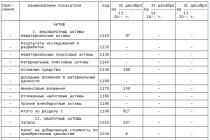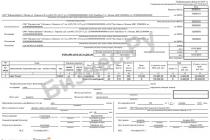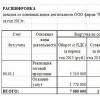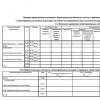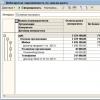56684
The waybill of a truck is filled in according to the form No. 4-C and No. 4-P. The first is filled in when the driver's salary is accrued at piece rates. The second is designed to fulfill two orders within one working day (shift). Here you can download examples of filling out and forms of waybills for a truck in form 4-c and form 4-p, which are currently used.
Forms
Download travel forms in excel:
- Form No. 4-c- to be filled in when the driver's salary is accrued at piece rates
- Form No. 4-p- designed to fulfill two orders within one working day (shift).
Before issuing the waybill to the driver, the dispatcher (authorized employee) fills in the waybill. After issuance - the owner of the vehicle and representatives of the customer. Tear-off coupons are filled in by the customer. On the basis of tear-off coupons, the organization issues invoices for payment for transport services (a tear-off coupon must be attached to the invoice).
When transporting goods and materials, it is necessary to enter the numbers of waybills in the waybill in the form No. 4-p, and also attach one copy of the waybill to the document. It is necessary to store waybills together with transport documents.
Related articles:
Samples
Form 4-c


Form No. 4-P


On the website of the electronic journal "Simplified" published forms and samples of all accounting and personnel documents in the current edition. , and you will get access to the "" section for free.
Filling order
Waybills of a truck are the main document of primary accounting, which, together with the consignment note for the transportation of goods, determines the indicators for accounting for the work of the rolling stock and the driver, as well as for calculating wages for the driver and making payments for the transportation of goods.
Form No. 4-c (piecework) is used when transporting goods, subject to payment for the car at piecework rates.
Form No. 4-p (time-based) is applied subject to payment for the operation of the car at a time-based rate and is designed for the simultaneous transportation of goods to two customers within one working day (shift) of the driver.
The tear-off coupons of the waybill are filled in by the customer and serve as the basis for the organization-owner of the vehicle to present an invoice to the customer.
The corresponding tear-off coupon is attached to the account.
The sheet remains in the organization - the owner of the vehicle, it repeats identical records about the time of the car at the customer's and serves as the basis for accounting for the work of the car during the working day.
In the case when inventory items will be transported with time-based payment for the operation of the car, the numbers of the shipping documents are entered on the sheet and one copy of these shipping documents is attached, as a result of which the number of tons of cargo transported and other indicators reflecting the operation of the car are indicated and driver.
Filling out the sheet before issuing it to the driver is carried out by the dispatcher of the organization or a person authorized to do so. The rest of the data is filled in by employees of the organization - the owner of the vehicle and customers.
Waybills according to forms No. 4-c and No. 4-p are issued to the driver against receipt by an authorized person for only one working day (shift), provided that the driver submits the sheet of the previous day of work.
The issued document must necessarily have the date of issue, the stamp and seal of the organization that owns the car.
The responsibility for the correct completion of the sheet lies with the heads of the organization, as well as persons responsible for the operation of trucks and participating in filling out the document.
Waybills are stored in the organization together with shipping documents, making it possible to check them simultaneously.



